According to recent research performed by an international group of astronomers, including a physicist at the University of St Andrews, the collision of two huge clusters of galaxies when the Universe was half its present age should not have occurred based on the conventional theory of cosmology.

Composite color image of the interacting galaxy cluster El Gordo, showing X-ray light from NASA’s Chandra X-Ray Observatory in blue, optical data from the European Southern Observatory's Very Large Telescope in red, green, and blue, and infrared emission from NASA's Spitzer Space Telescope in red and orange. Image Credit: X-Ray: NASA/CXC/Rutgers/J. Hughes et al; Optical: ESO/VLT & SOAR/Rutgers/F. Menanteau; IR: NASA/JPL/Rutgers/F. Menanteau
As per the Lambda-cold dark matter (ΛCDM) standard model of cosmology, galaxies form first and only later merge into bigger clusters of galaxies. Hence, galaxy clusters must take sufficient time to appear on the cosmic scene.
The new study reported in the Astrophysical Journal challenges this by showing that two extremely huge galaxy clusters crashed at a very high speed when the Universe was just around half its current age.
The cluster pair in question is called El Gordo, which means “The Fat One” in Spanish – an appropriate name given its mass is around 2000 trillion times that of the Sun (2 followed by fifteen zeroes).
The new study makes use of an updated estimate of its mass that is highly precise. This eliminates a significant source of doubt in an earlier study performed by the same authors around just how difficult El Gordo is for ΛCDM.
The mass was evaluated utilizing the deflection of light from background galaxies, whose shape looks distorted as a result of the gravitational pull from El Gordo–a bit like a magnifying glass.
This so-called “weak lensing” mass was achieved utilizing the Hubble Space Telescope but matches with more recent outcomes from the James Webb Space Telescope and other studies utilizing other methods. The mass currently has a modest 10% uncertainty.
The study headed by Elena Asencio, a Ph.D. student at the University of Bonn, utilized earlier published elaborate simulations of the interaction to evaluate the speed at which the clusters collided.
Further, the authors searched using a less elaborate cosmological ΛCDM simulation spanning a huge volume to look for simulated cluster pairs. The goal was to count how many of these are widely analogous to what El Gordo was like just before the collision.
This was performed with a groundbreaking “lightcone tomography” technique, which considers that highly distant objects are viewed a lot further in time when there was less structure.
The findings indicate a significant tension with the ΛCDM model, regardless of the plausible collision velocities considered. Additionally, any remaining uncertainties in El Gordo’s mass are no longer seen as a major contributing factor to this tension.
The results of our previous study were questioned by some scientists once an updated mass estimate for El Gordo was published and came in slightly lower. This does reduce the tension with ΛCDM, but it is still highly significant for any plausible collision velocity. Hundreds of detailed simulations show that El Gordo cannot look like the photos with a much slower collision velocity that could plausibly arise in ΛCDM.
Elena Asencio, Ph.D. Student, University of Bonn
While providing a simulation that appears like El Gordo with a highly rapid collision is feasible, such an event is rare in ΛCDM. This is because it would be highly strange to determine two such huge clusters within striking distance at such an early stage in cosmic history.
Additionally, needing them to be headed toward each other at a high speed stretches credibility. The new study performed and the more accurate mass measurement might result in more efforts to simulate El Gordo to better comprehend this enigmatic object.
El Gordo is not the only example of a cluster collision at odds with ΛCDM.
The Bullet Cluster is another example of a highly energetic collision between two galaxy clusters, albeit at a later epoch. Taken in combination with El Gordo, the situation becomes even worse for ΛCDM. And several other examples are known and mentioned in our study.
Dr. Indranil Banik, School of Physics and Astronomy, University of St Andrews
Banik developed the statistical analysis that has been utilized in this project.
Also, numerous studies are exhibiting that separate galaxies seem to develop much more quickly compared to what is expected in ΛCDM, largely as a result of very recent James Webb data. Of the broader context of the El Gordo outcomes.
Pavel Kroupa—Professor at the University of Bonn and Charles University in Prague—stated, “There is now a lot of evidence that structure formation in the Universe occurred faster than expected in ΛCDM. We are currently exploring other lines of evidence for this.”
Journal Reference
Asencio, E., et al. (2023) The El Gordo Galaxy Cluster Challenges ΛCDM for Any Plausible Collision Velocity. The Astrophysical Journal. doi.org/10.3847/1538-4357/ace62a.